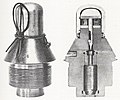Vaizdas:No106FuzeSectionPhoto.jpg

Šios peržiūros dydis: 712 × 600 taškų. Kitos 2 rezoliucijos: 285 × 240 taškų | 570 × 480 taškų.
Didesnės raiškos iliustracija (800 × 674 taškų, rinkmenos dydis: 109 KiB, MIME tipas: image/jpeg)
Rinkmenos istorija
Paspauskite ant datos/laiko, kad pamatytumėte rinkmeną tokią, kokia ji buvo tuo metu.
| Data/Laikas | Miniatiūra | Matmenys | Naudotojas | Paaiškinimas | |
|---|---|---|---|---|---|
| dabartinis | 09:12, 5 liepos 2008 |  | 800 × 674 (109 KiB) | Rcbutcher | {{Information |Description= |Source= |Date= |Author= |Permission= |other_versions= }} |
| 13:48, 29 birželio 2008 |  | 640 × 534 (200 KiB) | Rcbutcher | {{Information |Description=Photograph showing sectioned British No. 106 direct-action percussion fuze, World War I vintage. |Source=British ordnance manual circa. 1916-1918 |Date=circa. 1916-1918 |Author=War Office, UK |Permission=Crown copyright expired |
Paveikslėlio naudojimas
Paveikslėlis yra naudojamas šiuose puslapiuose:
Visuotinis rinkmenos naudojimas
Ši rinkmena naudojama šiose viki svetainėse:
- Naudojama da.wikipedia.org
- Naudojama de.wikipedia.org
- Naudojama en.wikipedia.org
- Naudojama pl.wikipedia.org
- Naudojama pt.wikipedia.org
- Naudojama ru.wiktionary.org
- Naudojama uk.wikipedia.org
- Naudojama www.wikidata.org

